User:Kai1701E/squadron/Tour
More actions
With three ships of varying ages making up the venerable Excelsior Squadron, it is not unexpected that the design aesthetic would be different across those three vessels. Whilst Excelsior is very new and polished due to her heavy refit, Arimathea and Buran are older, and most importantly, they have carpets!
Key Location Data
- Main Article: Excelsior deck listing
- Main Article: Tour of the Excelsior
With 24 decks, the ship has hundreds of rooms and locations that serve a variety of purposes for the crew. Some of the more notable locations include:
USS Excelsior NCC-42037 | Squadron Flagship
Bridge
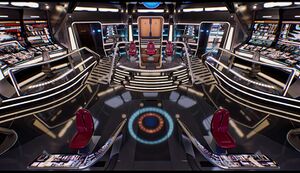
A reflection of the time period she was created, the Excelsior II-class' polished steel, cool metal fixtures and her bridge aesthetics bring back memories of years gone by, her design blending modern technological advancements with the nostalgia of eras long gone. It is a functional, yet aesthetically pleasing facility designed in a similar vein to the rest of the ship. Her greatest feature is a wide-angled window which fills the forward bulkhead. This window has holographic projectors built into the rim, giving it the ability to function as a more traditional viewscreen. It can also be used as an emergency evacuation hatch, with forcefields being lowered until replaced by a large, external bulkhead.
Dominating the heart of the command center, three command chairs made of red leather sit atop the central platform, colloquially known as the 'Command Deck', surrounded by rails and steps to the lower levels of the bridge. As is tradition, the center seat and its controls are reserved for the commanding officer, or any directly appointed officer in command during her absence. To her right, the executive officer and, to her left, a third seat is generally reserved for the use of the ship's Counsellor, Chief Medical Officer or any official or dignitary the Captain sees fit. All three of the chairs have built-in controls on the armrests, enabling the occupying officers to conduct their duties with unprecedented access to a wide variety of ship systems.
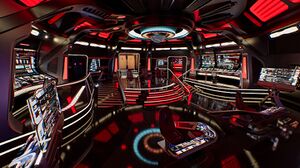
At the foot of the stairs directly ahead (or to the side) of the command deck, the 'Flight Deck' consists of two angled consoles serving as duty stations for operations (port) and flight operations (starboard). A few feet from each, two stand-alone consoles provide auxiliary station access for any purpose required (such as communications, environmental control, mission operations etc). Ascending the stairs on either side of the command deck, the port side bulkhead is home to three large stations dedicated to tactical operations, providing access to the ship's defensive and offensive systems, whilst the starboard bulkhead is dedicated to the various science departments on the ship.
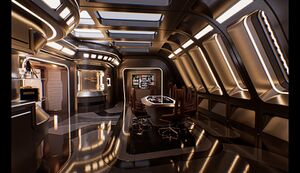
Aft of the bridge, there are two additional consoles behind the command area designated for medical use (port) and engineering (starboard), allowing the engineer on duty access to the same engineering systems as in main engineering itself, including access to environmental controls, propulsion systems and the warp core. Central to the aft bulkhead, open access is granted to the observation lounge, which is sealable by emergency bulkheads and forcefields.
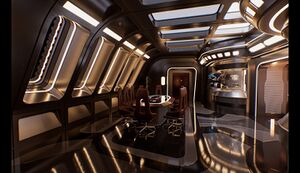
Observation Lounge
A beautifully designed room, the observation lounge matches the aesthetic of the rest of the ship, with polished alloys and cool metals as the material of choice during construction. The room is dominated by a large table with holographic controls which is particularly useful for briefings and has seating for up to 10 officers. The Captain traditionally sits closest to the wall-mounted display on the starboard bulkhead. There are several shelves with ornaments and models of previous ships called Excelsior, as well as the original USS Excelsior ship plaque. An additional door provides access from the port bulkhead.
The observation lounge operates an open-door policy and, in the absence of a more traditional ready room attached to the bridge, the Captain often uses the observation lounge as a workspace so that they do not have to return to their quarters, where their actual office is located.
Starlight Lounge
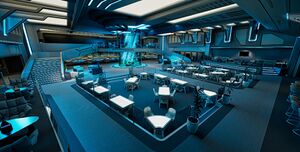
Perhaps the most spacious of all recreational facilities aboard Excelsior, the Starlight Lounge is built across two levels and is the most spacious facility on the ship. With dozens of seating areas across both levels, with varying degrees of comfort and privacy, the room is a constant hive of activity for anyone and everyone aboard the ship. People come to work in a relaxed, but active environment, or they may come to sit and read while people mill about and conduct their business. Food is obtained from several replicators around the room, while bar snacks and beverages are available at the bar which is manned around the clock. The room's most exquisite feature is the large, floor-to-ceiling aquarium tank which is maintained by the science division and houses some thirty different species of marine life.
USS Buran NCC-81711 | Squadron Scout Vessel
USS Osiris NCC-86401 | Squadron Frigate
Bridge, Deck One
Modelled on the successful layout of older, larger vessels such as the Sovereign-class, the bridge of the Osiris has a slightly altered colour scheme and a much-changed console layout across the bridge. Making the most of a variety of technological advancements, such as holoprojectors, holographic communications, in-built weapons lockers and three-dimensional computer displays in places, the Reliant-class bridge module is one of the most advanced in the fleet. Perhaps one of its most charming features is the emblem of the United Federation of Planets emblazoned on the carpeting as a constant reminder of all the ship stands for.
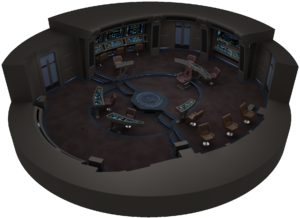
In a move away from more recent styles, and harking back to the traditional layouts of yesteryear, the Osiris has a single center command seat for the commanding officer allowing the occupant full view of all stations. Directly ahead of them, down a few steps and between the commanding officer and the holographic viewscreen, two angled consoles serve as duty stations for Operations (port) and Flight Operations (starboard). Next, and facing into the heart of the bridge to allow maximum participation with the rest of the bridge crew are duty stations for science (port) and tactical operations (starboard). Directly behind the commanding officer, and in a further break from tradition, a combined duty station serves as positioning for the two most senior advisors and assistants to the ship's commander; the Executive Officer (starboard) and, when appropriate, the mission advisor or specialist (port). Around the outside of the bridge, there are countless other additional stations. Behind the main science station on the port bulkhead, additional science and medical consoles are available for mission operations, as well as access to life support and environmental controls. Adjacent to them on the starboard bulkhead, mission operations and security stations ensure the continued safety of the ship and crew on a day-to-day, mission-by-mission basis. On the aft bulkhead, engineering is the focus. With a large, entirely interactive and customizable master systems display (MSD) and other engineering controls, the representative from engineering has full access to the ship's systems.
Around the command center, four doors provide access to and from the bridge. On the forward port bulkhead, access is available to the observation lounge, whilst the starboard door grants access to the commanding officer's private ready room (available for use by any officer in command of the ship). At the aft of the bridge, both doors provide access to turbo lifts which enable the crew to access the command center from the rest of the bridge. The starboard turbo lift grants express, overridden access to key locations such as engineering, shuttlebay 1, sickbay, tactical astrometrics and transporter rooms 1 and 2.
